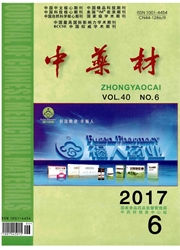

 中文摘要:
中文摘要:
目的:探讨自然环境对不同基原党参原植物遗传和化学成分的影响。方法:采用AFLP分子标记与HPLC指纹图谱技术分别对3个种群24个居群和10批党参药材进行遗传多样性和指纹图谱分析。结果:UPGMA方法聚类分析结果显示24个居群按照物种分类聚为3类。自甘肃文县和四川九寨沟县迁地引种的素花党参居群聚为第Ⅰ类。自湖北省板桥镇引种的川党参居群单独归为第Ⅱ类。迁地引种的党参居群与山西不同地理分布的野生及家种党参居群聚为第Ⅲ类。迁地引种的3个基原10批党参药材与对照图谱之间的相似度大于0.8,其化学成分趋于相似,有较好的一致性。结论:包括原产地及其迁地引种的不同基原党参种群间遗传差异由其物种内在的遗传特性引起,党参种内居群间遗传相似性与地理分布又呈一定相关性,而3个基原党参药材的化学成分则更易受到栽培环境因素的影响。
 英文摘要:
英文摘要:
Objective: To investigate the influence of environment on the genetic structure and chemical ingredients of different Codonopsis species. Methods: Amplified fragment length polymorphism( AFLP) molecular markers were used to analyze the genetic polymorphism of Codonopsis species from 24 different populations,and high performance liquid chromatography( HPLC) fingerprints were performed to analyze the chemical ingredients of 10 batches of Codonopsis roots. Results: According to species classification,the 24 populations were categorized into three groups by UPGMA cluster method. The samples of Codonopsis pilosula var. modesta introduced from Wenxian( Gansu Province) and Jiuzhaigou County( Sichuan Province) were clustered into Group Ⅰ. The Codonopsis tangshen population introduced from Banqiao( Hubei Province) was clustered into Group Ⅱ. The populations from Codonopsis pilosula introduced to Shanxi Province GAP base,and the wild and cultured populations of Codonopsis pilosula collected from Shanxi Province were into Group Ⅲ.The similarity of HPLC fingerprints among three Codonopsis species introduced into the same environment was over 0. 8. Conclusion: Genetic differences of three Codonopsis species from original areas and Codonopsis species introduced into Shanxi Province were caused by their inter-species genetic characteristic. Meanwhile,the similarities of genetic backgrounds in Codonopsis species were related to geographic space,and chemical ingredients of Codonopsis were easily influenced by the cultivation environment.
 同期刊论文项目
同期刊论文项目
 同项目期刊论文
同项目期刊论文
 期刊信息
期刊信息
